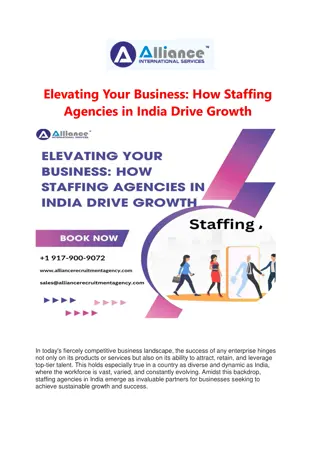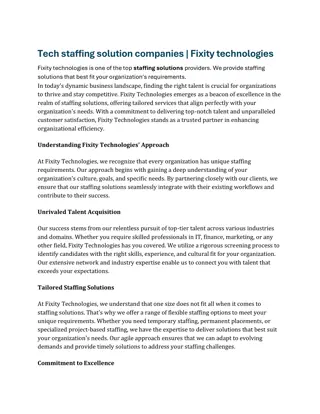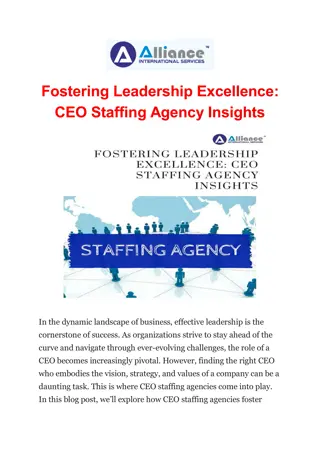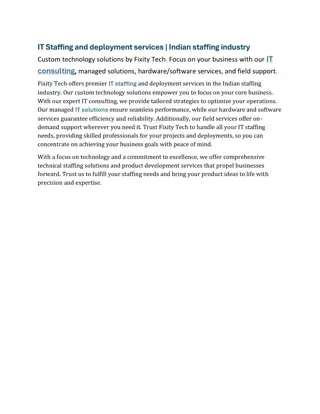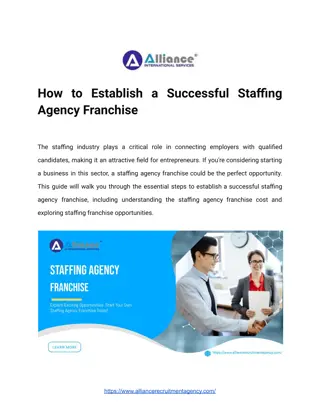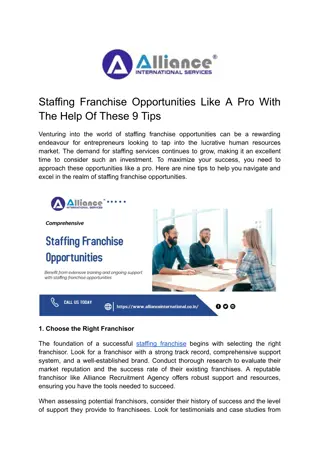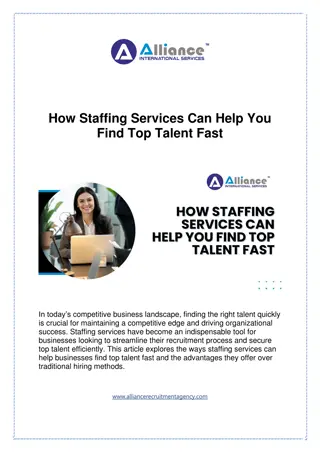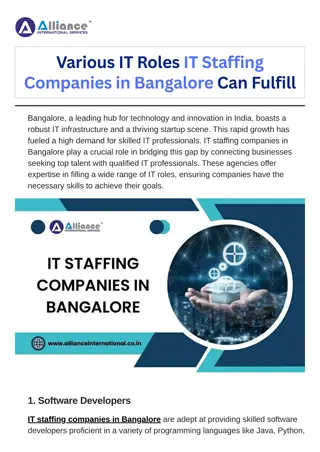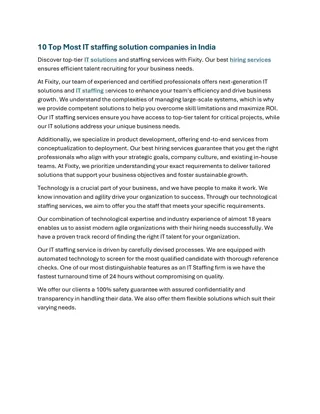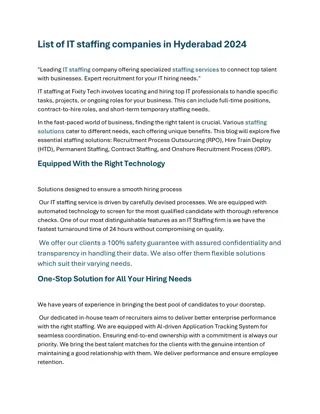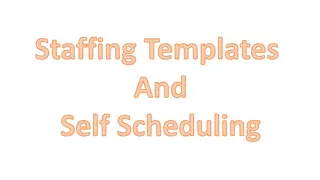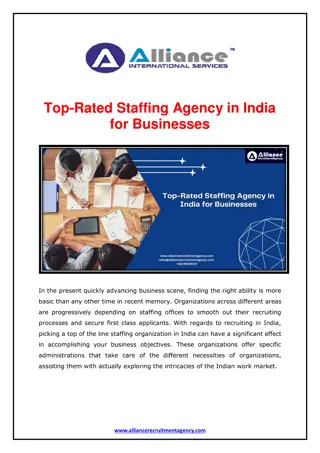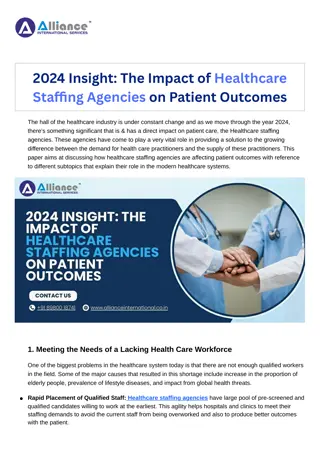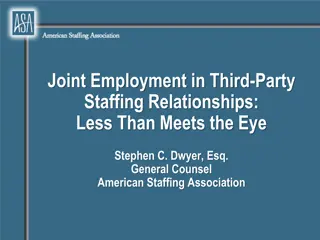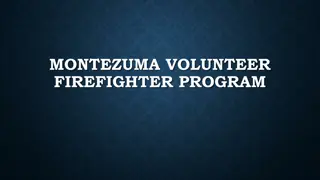Staffing Organizations Model Support Activities
In the staffing model, support activities such as legal compliance, planning, job analysis, and rewards play a crucial role. Legal compliance ensures fair treatment in the employment process while planning involves forecasting labor demand and supply to address gaps. External influences like economic conditions also impact HR staffing and planning decisions.
Download Presentation

Please find below an Image/Link to download the presentation.
The content on the website is provided AS IS for your information and personal use only. It may not be sold, licensed, or shared on other websites without obtaining consent from the author.If you encounter any issues during the download, it is possible that the publisher has removed the file from their server.
You are allowed to download the files provided on this website for personal or commercial use, subject to the condition that they are used lawfully. All files are the property of their respective owners.
The content on the website is provided AS IS for your information and personal use only. It may not be sold, licensed, or shared on other websites without obtaining consent from the author.
E N D
Presentation Transcript
Staffing Organizations Model Support activities 1-Legal Compliance 2- Planning Class-2 HR-302
Staffing Organizations Model The organization mission and its goals and objectives drive both organization strategy and HR and staffing strategy. organization strategy and HR and staffing strategy interact with each other when they are being formulated, staffing policies and programs result from that interaction, and they serve as an overlay to both support activities and core staffing activities. Employee retention and staffing system management concern cut across support and core staffing activities.
Support activities 1- Legal Compliance 2- Planning 3- Job Analysis and Rewards
Legal compliance When the organization acquires people to do work for it, legal employment relation is established. The acquired people may be employees, independent contractors, or temporary employees. Laws are needed to define how the employer may use each type, as well as the rights of each type. Laws have been developed to create fairness and nondiscrimination in staffing such as race discrimination, and disability.
Planning HR Planning is the process and set of activities undertaken to forecast an organization s labor demand (requirement) and internal labor supply (availabilities), to these projections to determine employment gaps. and to develop action plans for addressing these gaps. Action plans include staffing planning to arrive at desired staffing levels and staffing quality.
External influences on HR staffing & planning Economic Conditions Economic expansion and contraction Job growth and job opportunities Internal labor market mobility Turnover rates Labor Markets Labor demand: organization requirements, KSAs Labor supply: KSAOs available Labor shortages (demand > supply) and surpluses (demand < supply)
What is Human Resource Planning (HRP)? Involves activities to Forecastan organization s Labor demand -- Requirements Internal labor supply -- Availabilities Compare projections to determine employment gaps Develop action plans to addressing the gaps Staffing planning
The Basic Elements of Human Resource Planning (1) Forecast Labor Requirements (5) Develop Action Plans (4) Determine Gaps Compare (2) Forecast Labor Availabilities
Staffing Planning This is a vital phase of the planning process. Staffing planning process: 1- Staffing objectives 2- Generating Alternative Staffing Activities 3-Assessing and Choosing Alternatives
Staffing objectives The objectives are the targets the organization establish to determine how many people will need and in which job category. They may require the establish of quantity and quality.
Generating Alternative Staffing Activities With quantitative and qualitative objectives established, it is necessary to begin identifying possible way of achieving them. There are many options available to deal with employee shortage and surpluses.
Generating Alternative Staffing Activities Surplus Shortage Hiring freeze Layoffs Transfer Retirement incentives Reduce work week Reduce part-time New Hires Transfer Training/Retrain Overtime Part-time
Assessing and Choosing Alternatives Each of this alternative need to be assessed to help the decision makers choose among them. The goal of such assessment is to identify one more preferred activities. A preferred activities offers the highest likelihood of attaining the staffing objective within the time limit established, at the least cost and with the fewest negative side effects.
How the organization creates and structures its workforce? This involves the key strategic issue of core versus flexible workforce usage. Core workforce: regular full-time and part- time employee. Flexible workforce: temporary employees provided by independent contractors.






